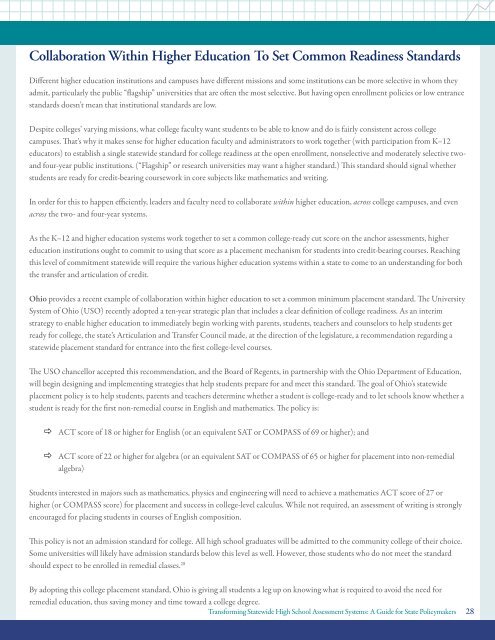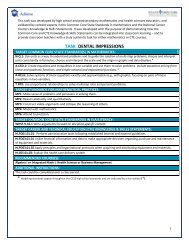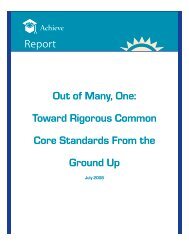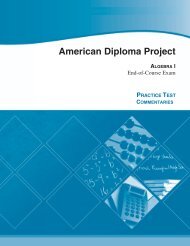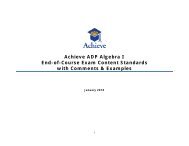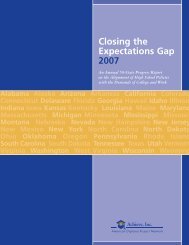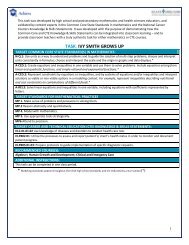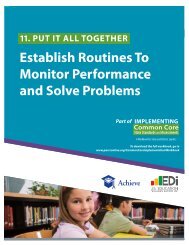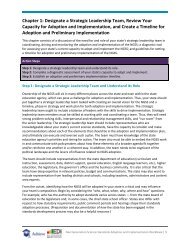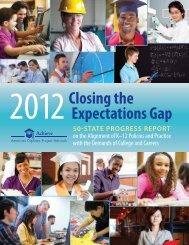Transforming Statewide High School Assessment Systems: - Achieve
Transforming Statewide High School Assessment Systems: - Achieve
Transforming Statewide High School Assessment Systems: - Achieve
Create successful ePaper yourself
Turn your PDF publications into a flip-book with our unique Google optimized e-Paper software.
Collaboration Within <strong>High</strong>er Education To Set Common Readiness StandardsDifferent higher education institutions and campuses have different missions and some institutions can be more selective in whom theyadmit, particularly the public “flagship” universities that are often the most selective. But having open enrollment policies or low entrancestandards doesn’t mean that institutional standards are low.Despite colleges’ varying missions, what college faculty want students to be able to know and do is fairly consistent across collegecampuses. That’s why it makes sense for higher education faculty and administrators to work together (with participation from K–12educators) to establish a single statewide standard for college readiness at the open enrollment, nonselective and moderately selective twoandfour-year public institutions. (“Flagship” or research universities may want a higher standard.) This standard should signal whetherstudents are ready for credit-bearing coursework in core subjects like mathematics and writing.In order for this to happen efficiently, leaders and faculty need to collaborate within higher education, across college campuses, and evenacross the two- and four-year systems.As the K–12 and higher education systems work together to set a common college-ready cut score on the anchor assessments, highereducation institutions ought to commit to using that score as a placement mechanism for students into credit-bearing courses. Reachingthis level of commitment statewide will require the various higher education systems within a state to come to an understanding for boththe transfer and articulation of credit.Ohio provides a recent example of collaboration within higher education to set a common minimum placement standard. The UniversitySystem of Ohio (USO) recently adopted a ten-year strategic plan that includes a clear definition of college readiness. As an interimstrategy to enable higher education to immediately begin working with parents, students, teachers and counselors to help students getready for college, the state’s Articulation and Transfer Council made, at the direction of the legislature, a recommendation regarding astatewide placement standard for entrance into the first college-level courses.The USO chancellor accepted this recommendation, and the Board of Regents, in partnership with the Ohio Department of Education,will begin designing and implementing strategies that help students prepare for and meet this standard. The goal of Ohio’s statewideplacement policy is to help students, parents and teachers determine whether a student is college-ready and to let schools know whether astudent is ready for the first non-remedial course in English and mathematics. The policy is:ACT score of 18 or higher for English (or an equivalent SAT or COMPASS of 69 or higher); andACT score of 22 or higher for algebra (or an equivalent SAT or COMPASS of 65 or higher for placement into non-remedialalgebra)Students interested in majors such as mathematics, physics and engineering will need to achieve a mathematics ACT score of 27 orhigher (or COMPASS score) for placement and success in college-level calculus. While not required, an assessment of writing is stronglyencouraged for placing students in courses of English composition.This policy is not an admission standard for college. All high school graduates will be admitted to the community college of their choice.Some universities will likely have admission standards below this level as well. However, those students who do not meet the standardshould expect to be enrolled in remedial classes. 28By adopting this college placement standard, Ohio is giving all students a leg up on knowing what is required to avoid the need forremedial education, thus saving money and time toward a college degree.<strong>Transforming</strong> <strong>Statewide</strong> <strong>High</strong> <strong>School</strong> <strong>Assessment</strong> <strong>Systems</strong>: A Guide for State Policymakers 28


